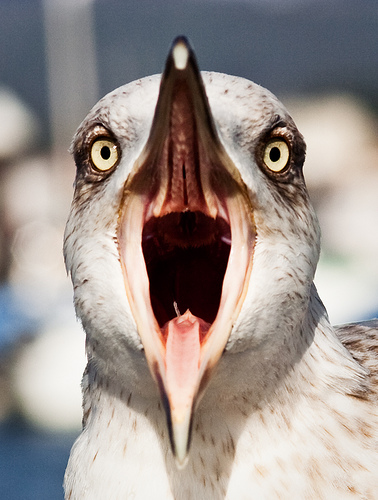With so many lenses on the market, all with different apertures and focal lengths, how do you know which is the best lens for wildlife photography?

The best lens for your wildlife photography depends on two very important considerations: what you will be shooting and your budget.
Lenses with long focal lengths (‘long lenses’) are expensive but as they magnify more than shorter focal length lenses they may help you get much better shots of animals from far away. Staying at a distance from the animals helps ensure your safety and it prevents you from disturbing the them.
If you plan on shooting animals from a long distance look for at least a 300 mm lens. A 400 mm or higher lens is a better choice because it allows you to be further away (but these lenses can be very expensive).
There isn’t really a single best lens for wildlife photography because there are so many different situations. The shot of the seagull shown here was taken with a 105mm lens! Obviously animals that are tame or used to human contact may not need such long lenses.
If you are shooting elusive animals that require you to be at a long distance (so that you don’t scare them) you will need a long focal length. Plan to buy the longest focal length lens you can afford so you can get pictures from further away.
If you plan on shooting wildlife from a shorter distance, such as birds and most small animals, look for a 200 mm or 300 mm lens. These lenses are much cheaper and they may be powerful enough depending on your needs.
Aperture
When choosing which lens to buy, also look at the aperture. An aperture of f/2.8 on a long lens gives you more versatility as the brighter image allows you to shoot in lower lighting conditions or (using the reciprocity law) select faster shutter speeds. However you’ll find that a lens with the same focal length as another will tend to be more expensive if it has a wider maximum aperture. This is because to funnel more light in to the lens (so that the image is brighter and you can take photographs at lower light levels) the manufacturer must use bigger lenses (or mirrors). It’s more expensive to produce larger lenses due not only to the amount of glass used but because of the costs involved in grinding and polishing bigger lenses.
Image Stabilization
Even the best lens has limitations at long distances. You should also consider an image stabilizer to reduce blurriness. Some lenses have gyroscopic image stabilization built in. This may not be enough for a long lens. As a minimum you should use a tripod when using long lenses (although you may find your images are sharper if you turn OFF gyroscopic image stabilisation when using a tripod). Even a small amount of shake at a long distance can ruin an otherwise great picture. If you regularly take photos on cold mornings, or during the winter, your hands shaking from the cold can also cause your camera to shake and result in a blurry photo.
Your camera also has limitations when you shoot wildlife photography. Since you can not control the light outside like you can in a studio, you need a camera that can shoot well in low light. Also, pressing the shutter release is likely to cause camera shake – so use a cable release.
Ultimately, your budget will determine which lens to buy. The best lens for taking photographs of wildlife may be highly influenced by your budget.
Top Tip for buying lenses:
- Always read a trusted review of the specific lens you are considering. Professional reviewers will subject the lens to a series of tests and be able to point out the good and bad aspects of the lens design.
- Ensure you select the best focal length for your needs: consider hiring/testing a lens of the same focal length to be sure as this may save you from making an expensive mistake.
- Remember that the maximum aperture tends to make a huge difference in cost. Ensure you check this specification before you buy. If you need a fast lens but buy a slower one – it may be money wasted.
- Buy suitable insurance – lens are expensive to replace!